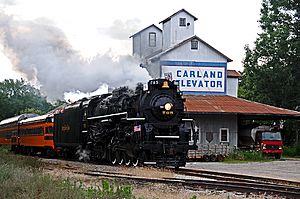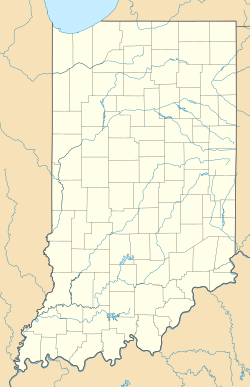Nickel Plate Road 765 facts for kids
Quick facts for kids Nickel Plate Road 765 |
|
| Power type | Steam |
|---|---|
| References: | |
| Builder | Lima Locomotive Works |
| Serial number | 8673 |
| Build date | September 8, 1944 |
| Rebuild date | 2000–2006 |
| Configuration | 2-8-4 |
| UIC classification | 1'D2'h |
| Gauge | 4 ft 8 1⁄2 in (1,435 mm) standard gauge |
| Leading wheel diameter | 36 in (0.914 m) |
| Driver diameter | 69 in (1.753 m) |
| Trailing wheel diameter | 43 in (1.092 m) |
| Length | 100 ft 8+3⁄4 in (30.70 m) |
| Height | 15 ft 8 in (4.78 m) |
| Weight on drivers | 264,300 lb (119,900 kg; 119.9 t) |
| Locomotive weight | 440,800 lb (199,900 kg; 199.9 t) |
| Locomotive and tender combined weight | 802,500 lb (364,000 kg; 364.0 t) |
| Fuel type | Coal |
| Fuel capacity | 44,000 lb (20,000 kg; 20 t) 22 short tons (20.0 t; 19.6 long tons) |
| Water capacity | 22,000 US gal (83,000 L; 18,000 imp gal) |
| Boiler | 89.0625 in (2.26 m) diameter × 42 ft (12.80 m) length |
| Boiler pressure | 245 psi (1.69 MPa) |
| Superheater type | Elesco |
| Cylinders | Two |
| Cylinder size | 25 in × 34 in (635 mm × 864 mm) |
| Valve gear | Baker |
| Tractive effort | 64,135 lbf (285.3 kN) |
| Factor of adhesion | 4.12 |
| Number in class | 11 |
| Retired | June 14, 1958 |
| Preserved | May 4, 1963 |
| Restored | September 1, 1979 |
| Current owner | Fort Wayne Railroad Historical Society |
| Disposition | Operational, based in New Haven, Indiana |
|
New York Chicago and St. Louis Railroad Steam Locomotive No. 765
|
|
| Location | 15808 Edgerton Rd., New Haven, Indiana |
| Area | less than one acre |
| Architectural style | S-2 class locomotive |
| NRHP reference No. | 96001010 |
| Added to NRHP | September 12, 1996 |
Nickel Plate Road 765 is a powerful steam locomotive. It was built in 1944 by the Lima Locomotive Works in Lima, Ohio. This engine is a "Berkshire" type, known for its 2-8-4 wheel setup. It was made for the New York, Chicago & St. Louis Railroad, also called the "Nickel Plate Road."
The 765 was designed to pull heavy freight and passenger trains very fast. It worked until it was retired in 1958. Later, it was brought back to life! After a big restoration in 1979 and another one from 2000 to 2006, No. 765 now runs special excursion trains for people to enjoy. The Fort Wayne Railroad Historical Society (FWRHS) owns and takes care of it. In 1996, it was even added to the National Register of Historic Places.
Contents
History of the 765
The Birth of "Super-power" Engines
Around the early 1900s, railroads faced a challenge. They had more goods to move, but their steam engines were slow. Trains that pulled heavy loads were called "drag freights." They were strong but not fast.
Engine builders like Lima Locomotive Works wanted to make better engines. They found a way to make the engine's firebox bigger. A larger firebox meant more coal could burn, creating more steam. More steam meant more power and speed! This new idea was called "horsepower at speed" or "Super-power."
The Berkshire Design
In 1925, Lima built a "Super-power" engine prototype called the A-1. It was tested in the Berkshire Mountains. That's how the 2-8-4 type of locomotive got its common name, "Berkshire." Many railroads quickly adopted this design.
The Nickel Plate Road eventually used 80 Berkshire engines. They were perfect for high-speed freight and passenger trains. No. 765 was part of the S-2 class, built in 1944. These engines were all known as the "Seven Hundreds." The Berkshire engines helped the railroad become famous for its fast service.
Working Years of No. 765
No. 765 was finished on September 8, 1944. Its first job was in Bellevue, Ohio. It mainly pulled fast freight trains for the Nickel Plate. After World War II, it worked mostly out of Fort Wayne, Indiana.
Its last official trip was on June 14, 1958. It was used to provide steam heat to a train that was stuck. Soon after, it was officially retired. By December of that year, it was the last Nickel Plate Road Berkshire still running.
Newspapers at the time praised these engines. They said the Berkshires were "the most colorful engines" and had "carved an enviable record." But they knew that newer diesel engines would soon take over.
Retirement and Preservation
By 1958, most Berkshire engines were retired. Many were stored outside and later scrapped. But No. 765 was special. It was kept indoors because it was in good shape.
The city of Fort Wayne wanted an engine for display in a park. They first asked for No. 767. But No. 767 was in bad condition. So, the railroad decided to donate No. 765 instead, after changing its number to 767 for the display. On May 4, 1963, the locomotive was given to the city. It was a monument to the "era of steam railroading."
Bringing 765 Back to Life

In 1971, some people met to talk about restoring No. 765. By 1972, they formed the Fort Wayne Railroad Historical Society, Inc.. In 1973, the FWRHS leased the engine. They moved it to New Haven, Indiana, to begin a full restoration. On October 25, the engine got its original number, 765, back.
The restoration took place outdoors, without a proper shop. But on September 1, 1979, No. 765 moved under its own power for the first time! It was a huge achievement. This made No. 765 the first mainline steam locomotive restored by an all-volunteer group.
First Excursion Adventures
In the 1980s, steam locomotives became popular again for special trips. No. 765 was even featured in movies like Four Friends and Matewan. It became a star attraction!
From 1985 to 1993, No. 765 regularly pulled the "New River Trains." These trips through the New River Gorge were very popular. Passengers came from all over the world to see the fall colors. In 1985, the FWRHS officially became the owner of 765.
No. 765 also teamed up with other famous engines. In 1991, it ran with Pere Marquette 1225. In 1993, it joined Nickel Plate Road 587. The 765 traveled across many major railroads. It pulled the New River Train 32 times! By 1994, it had led 124 trips for Norfolk Southern. Magazines called it a "veteran excursion engine."
A Break for Repairs
By 1993, No. 765 had traveled over 115,000 miles (185,000 km) since its last major overhaul. About 52,000 miles (84,000 km) of that was during its excursion career. The engine needed a lot of repairs. So, from 1993 to 2001, 765 was mostly on display.
The FWRHS decided to focus all their efforts on a complete overhaul of 765. This would make sure it could run safely for many more years.
The Big Overhaul and Return
The FWRHS received grants and donations for the overhaul. Volunteers did a lot of the work. For five years, 765 was taken completely apart. Its boiler, frame, and other parts were repaired or rebuilt.
In July 2005, the locomotive passed a steam test. In October, it was shown to the public. Fort Wayne even declared October 28, 2005, "Engine no. 765 Day." In March 2006, it completed its test runs. The rebuild took over 15,000 hours and cost more than $772,000.
In 2006, the FWRHS won awards for their amazing restoration work. It was hard to find railroads willing to host steam excursions at first. But on May 21, 2009, 765 made its first trips in sixteen years!
From 2009 to 2011, 765 ran many passenger trips. It traveled on regional railroads. It even crossed the Mississippi River for the first time!
In 2012, Norfolk Southern leased 765 for special employee trips. The FWRHS put a GPS tracker on 765. Over 120,000 people watched its journey online! It was also the first steam locomotive to have an active Twitter presence.
In 2013, 765 joined Norfolk Southern's "21st Century Steam" program. It ran public trips in Ohio and Pennsylvania. It even ran over Horseshoe Curve for the first time since 1977. Later that year, it ran trips from Fort Wayne to Lafayette, Indiana. This was the first time a steam excursion left Fort Wayne since 1993.
In 2015, 765 had a busy schedule. It traveled from Fort Wayne to Lafayette. It also went from Youngstown to Ashtabula, Ohio. Another trip took it from Buffalo to Corning, New York. A highlight was crossing the Portage Viaduct. It also ran to Allentown, Pennsylvania. While in Scranton, Pennsylvania, it was housed next to Nickel Plate Road 759.
From 2016 to 2018, 765 partnered with Metra, Chicago's commuter rail system. It pulled the "Varsity" train from North Glenview to Janesville, Wisconsin. It also pulled the "Joliet Rocket" between Joliet and Chicago. The 765 continues to operate special events and passenger excursions each year.
The Impact of Tourism
When No. 765 is running, about 3,000 visitors come to see it each day. In 2009 and 2011, between 40,000 and 60,000 people bought tickets for its trips. A typical train carries 600 to 1,000 people. Tickets often sell out in just 24 hours!
News reports often talk about the huge crowds that gather. They say 765 helps boost tourism in the towns it visits. One newspaper called it the "engine that still can." Another called it "400 tons of Americana."
When it's not running, 765 is maintained by 70–100 volunteers. They work in a shop in New Haven, Indiana. The shop is open to the public. It also houses other old railroad equipment. The FWRHS raises money through memberships, donations, and ticket sales to keep 765 running.
The Future of 765
Besides pulling passenger trains, 765 is a key part of a new project. It's called Headwaters Junction. This project aims to create a mixed-use attraction in Fort Wayne. It would combine railroad tourism with river access and walking trails. It would also have shops, restaurants, and entertainment. City leaders believe Headwaters Junction will be a "big, bold, and transformational" project for the city.
Images for kids
-
No. 765 passing through Secor, Illinois with its inaugural excursion run on May 11, 1980
-
No. 765 on the turntable at the Steamtown National Historic Site in 2015





